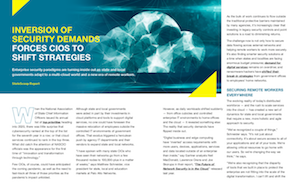- Sponsored
- State
SASE: A new vision of the security perimeter for enterprise networks

Today’s users require access to public sector resources from anywhere and everywhere. While the COVID-19 pandemic was a catalyst for this overwhelming shift in user needs, many leaders expect their user expectations for remote and hybrid access to be a lasting effect of the crisis.

Read the full report.
As organizations continue to fast-track their cloud services and digital transformation strategies, this shift to remote access has effectively inverted where enterprises have primarily focused their IT security attention, says a recent report produced by StateScoop and underwritten by Palo Alto Networks.
“The collection of security tools that protect the physical enterprise and [public sector] networks no longer align with the scale of digital transformation for the remote workforce,” says Matthew Schneider, vice president for state, local and education markets at Palo Alto Networks.
“[Agencies] can’t lift and shift the technology that’s built on IP addresses to a technology like containers, because these applications that don’t rely on IP addresses; they rely on understanding the workload all the way through … the user experience, with a consistent understanding of user visibility and context,” he explains in the report.
As more users, devices, applications, services and data off-premise, investing in legacy security controls and point solutions will be “a road to diminishing returns.” That is driving leaders to turn to “secure access service edge” — or SASE solutions — like Palo Alto Networks’ Prisma Access and other security-as-a-service capabilities, the report says.
SASE solutions are expected to increase dramatically, the report says, citing research from Gartner estimating that by 2024, at least 40% of enterprises will have explicit strategies to adopt SASE, compared to less than 1% at year-end 2018.
“We’ve recognized a couple of things,” Schneider explains. “It’s not just about connectivity. It’s about secure access to all of your applications and all of your tools. We’re allowing critical resources to go home with our users.”
“If you look at how much of the industry has approached zero trust, it’s been primarily zero trust inside of my network,” Schneider says. However, the extended operating environment makes it essential to “have a control plane, across the enterprise, all the way out to that end user, and that end user’s device, and then the context of that trust, all the way through the workflow session.”
The pandemic has only fast-tracked an existing enterprise security paradigm as organizations adapt to a multi-cloud world. The distributed workforce, and rush to scale services into the cloud, means that state and local government leaders need a holistic and agile approach to security.
The report highlights new research from Palo Alto Networks and Accenture Security on the rapid evolution of cloud native security, including the fact that 6 in 10 organizations use anywhere from two to five cloud platforms, forcing enterprises to look toward single end-to-end cloud security solutions.
The report also touches on the nature of fourth-generation firewall capabilities and offers five recommendations for building a more modern enterprise security platform.
Learn more how Palo Alto Networks can help public sector and higher education organizations secure their IT future.
This article was produced by StateScoop and sponsored by Palo Alto Networks.






